Sweet: A Marketing Project and Advertising Campaign for a New Company
VerifiedAdded on 2023/05/28
|25
|7950
|324
Project
AI Summary
This project presents a comprehensive marketing analysis and plan for "Sweet," a new company in the sharing economy, positioning itself as a competitor to Airbnb. The project begins with an executive summary and an examination of the external business environment, including potential political and economic impacts. It delves into value extraction and strategic control points, followed by a value chain analysis, including supply chain, in-house value creation, marketing strategies, and value propositions for guests. Core capabilities are mapped, and the project explores market segmentation, including demographic, geographic, and behavioral segmentation, alongside a detailed product strategy incorporating conjoint analysis and demand elasticity estimation. Competitive strategies, cost estimation, and pricing principles are analyzed, culminating in customer points of access and distribution strategies. The project then presents recommendations and an internal advertising campaign strategy, including media planning, budget allocation, and a creative brief. The advertisement section includes the background, target audience, objectives, and key performance indicators (KPIs) to measure the campaign's success. References are also included.
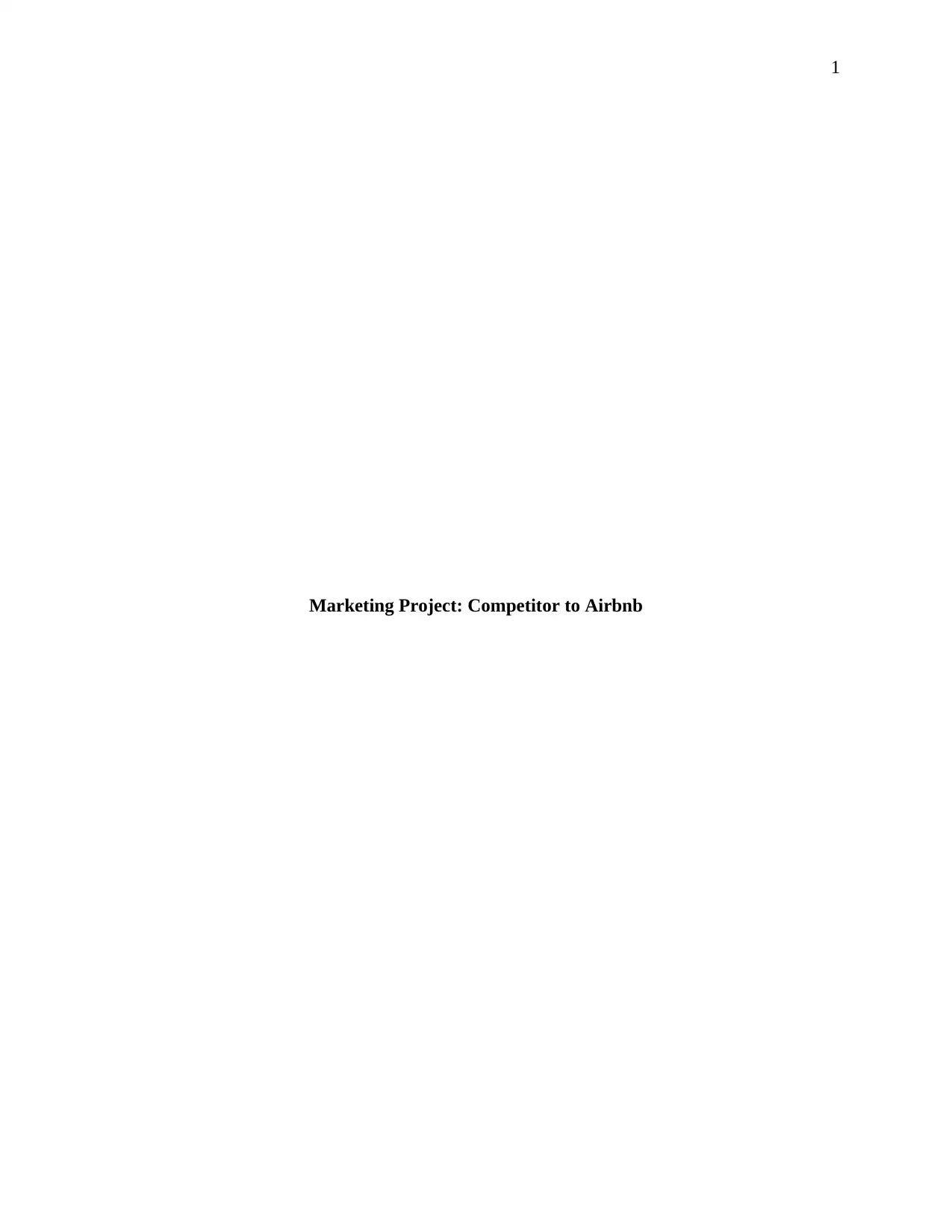
1
Marketing Project: Competitor to Airbnb
Marketing Project: Competitor to Airbnb
Paraphrase This Document
Need a fresh take? Get an instant paraphrase of this document with our AI Paraphraser
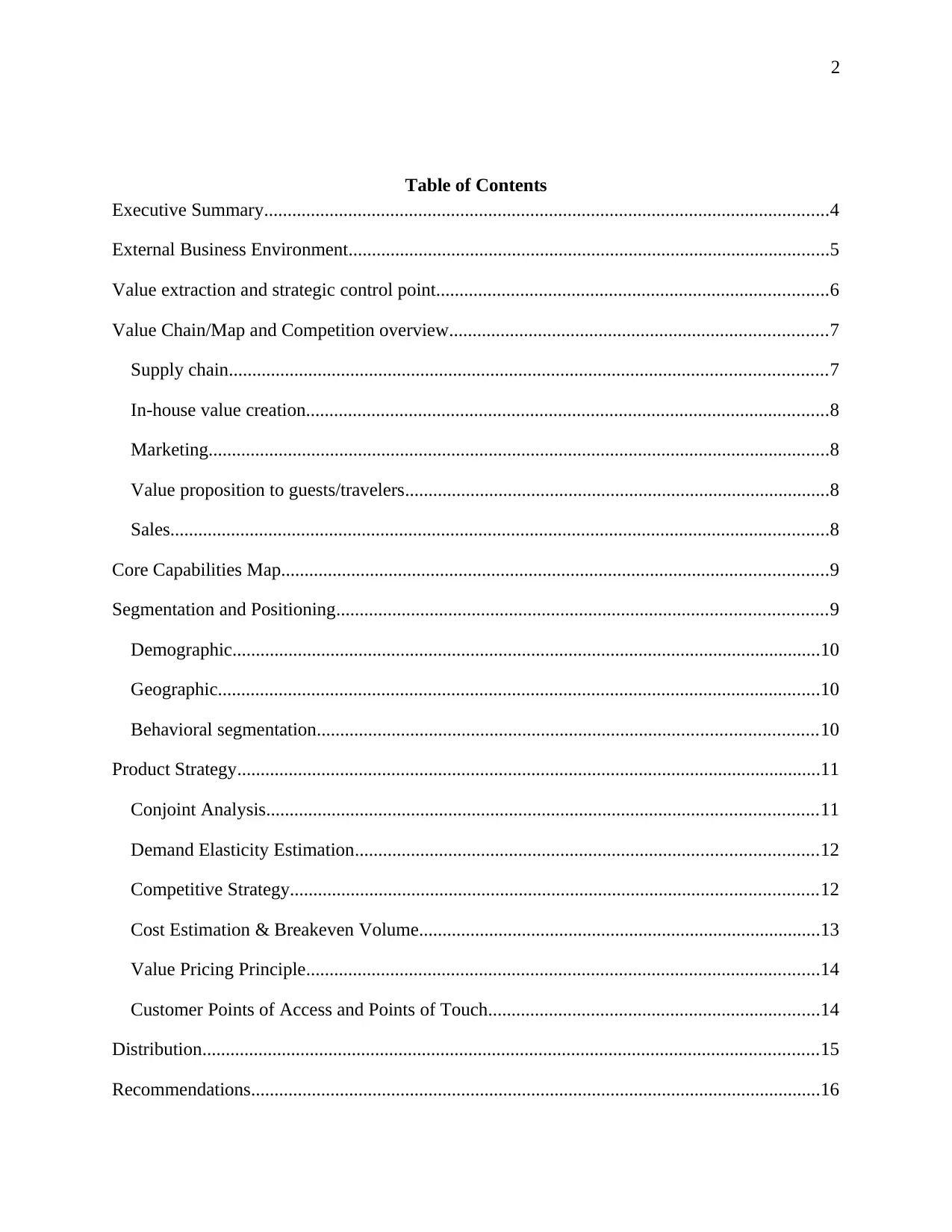
2
Table of Contents
Executive Summary.........................................................................................................................4
External Business Environment.......................................................................................................5
Value extraction and strategic control point....................................................................................6
Value Chain/Map and Competition overview.................................................................................7
Supply chain................................................................................................................................7
In-house value creation................................................................................................................8
Marketing.....................................................................................................................................8
Value proposition to guests/travelers...........................................................................................8
Sales.............................................................................................................................................8
Core Capabilities Map.....................................................................................................................9
Segmentation and Positioning.........................................................................................................9
Demographic..............................................................................................................................10
Geographic.................................................................................................................................10
Behavioral segmentation...........................................................................................................10
Product Strategy.............................................................................................................................11
Conjoint Analysis......................................................................................................................11
Demand Elasticity Estimation...................................................................................................12
Competitive Strategy.................................................................................................................12
Cost Estimation & Breakeven Volume......................................................................................13
Value Pricing Principle..............................................................................................................14
Customer Points of Access and Points of Touch.......................................................................14
Distribution....................................................................................................................................15
Recommendations..........................................................................................................................16
Table of Contents
Executive Summary.........................................................................................................................4
External Business Environment.......................................................................................................5
Value extraction and strategic control point....................................................................................6
Value Chain/Map and Competition overview.................................................................................7
Supply chain................................................................................................................................7
In-house value creation................................................................................................................8
Marketing.....................................................................................................................................8
Value proposition to guests/travelers...........................................................................................8
Sales.............................................................................................................................................8
Core Capabilities Map.....................................................................................................................9
Segmentation and Positioning.........................................................................................................9
Demographic..............................................................................................................................10
Geographic.................................................................................................................................10
Behavioral segmentation...........................................................................................................10
Product Strategy.............................................................................................................................11
Conjoint Analysis......................................................................................................................11
Demand Elasticity Estimation...................................................................................................12
Competitive Strategy.................................................................................................................12
Cost Estimation & Breakeven Volume......................................................................................13
Value Pricing Principle..............................................................................................................14
Customer Points of Access and Points of Touch.......................................................................14
Distribution....................................................................................................................................15
Recommendations..........................................................................................................................16
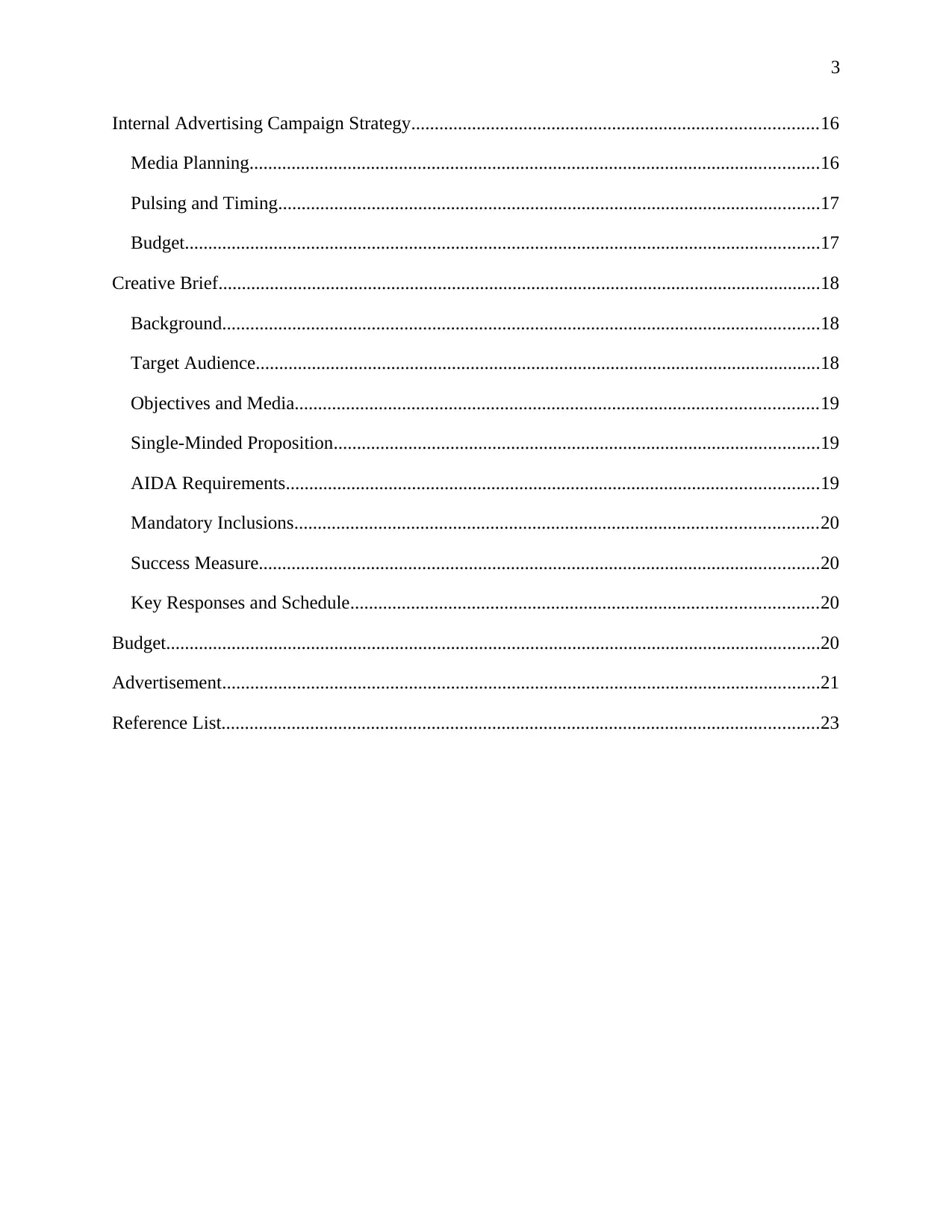
3
Internal Advertising Campaign Strategy.......................................................................................16
Media Planning..........................................................................................................................16
Pulsing and Timing....................................................................................................................17
Budget........................................................................................................................................17
Creative Brief.................................................................................................................................18
Background................................................................................................................................18
Target Audience.........................................................................................................................18
Objectives and Media................................................................................................................19
Single-Minded Proposition........................................................................................................19
AIDA Requirements..................................................................................................................19
Mandatory Inclusions................................................................................................................20
Success Measure........................................................................................................................20
Key Responses and Schedule....................................................................................................20
Budget............................................................................................................................................20
Advertisement................................................................................................................................21
Reference List................................................................................................................................23
Internal Advertising Campaign Strategy.......................................................................................16
Media Planning..........................................................................................................................16
Pulsing and Timing....................................................................................................................17
Budget........................................................................................................................................17
Creative Brief.................................................................................................................................18
Background................................................................................................................................18
Target Audience.........................................................................................................................18
Objectives and Media................................................................................................................19
Single-Minded Proposition........................................................................................................19
AIDA Requirements..................................................................................................................19
Mandatory Inclusions................................................................................................................20
Success Measure........................................................................................................................20
Key Responses and Schedule....................................................................................................20
Budget............................................................................................................................................20
Advertisement................................................................................................................................21
Reference List................................................................................................................................23
⊘ This is a preview!⊘
Do you want full access?
Subscribe today to unlock all pages.

Trusted by 1+ million students worldwide
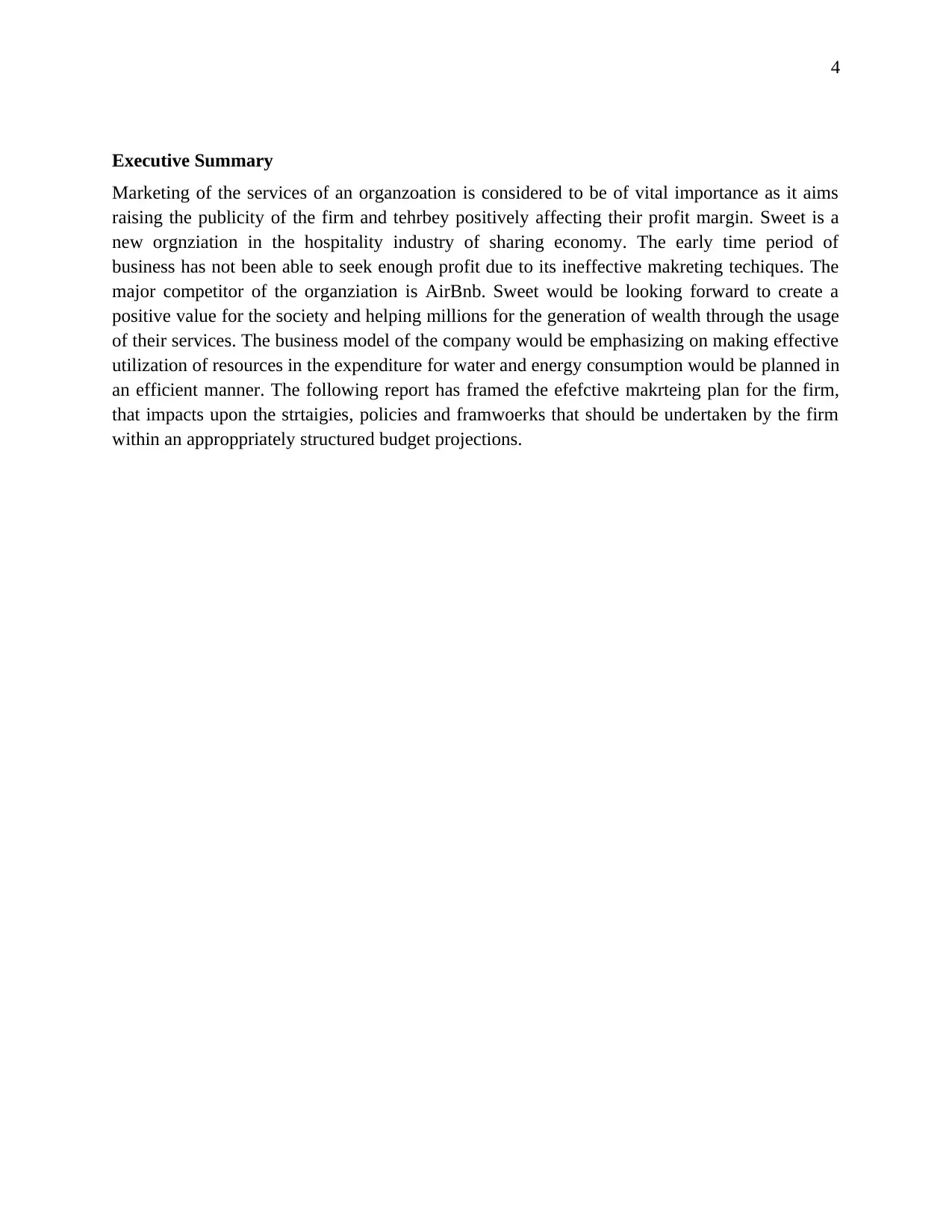
4
Executive Summary
Marketing of the services of an organzoation is considered to be of vital importance as it aims
raising the publicity of the firm and tehrbey positively affecting their profit margin. Sweet is a
new orgnziation in the hospitality industry of sharing economy. The early time period of
business has not been able to seek enough profit due to its ineffective makreting techiques. The
major competitor of the organziation is AirBnb. Sweet would be looking forward to create a
positive value for the society and helping millions for the generation of wealth through the usage
of their services. The business model of the company would be emphasizing on making effective
utilization of resources in the expenditure for water and energy consumption would be planned in
an efficient manner. The following report has framed the efefctive makrteing plan for the firm,
that impacts upon the strtaigies, policies and framwoerks that should be undertaken by the firm
within an approppriately structured budget projections.
Executive Summary
Marketing of the services of an organzoation is considered to be of vital importance as it aims
raising the publicity of the firm and tehrbey positively affecting their profit margin. Sweet is a
new orgnziation in the hospitality industry of sharing economy. The early time period of
business has not been able to seek enough profit due to its ineffective makreting techiques. The
major competitor of the organziation is AirBnb. Sweet would be looking forward to create a
positive value for the society and helping millions for the generation of wealth through the usage
of their services. The business model of the company would be emphasizing on making effective
utilization of resources in the expenditure for water and energy consumption would be planned in
an efficient manner. The following report has framed the efefctive makrteing plan for the firm,
that impacts upon the strtaigies, policies and framwoerks that should be undertaken by the firm
within an approppriately structured budget projections.
Paraphrase This Document
Need a fresh take? Get an instant paraphrase of this document with our AI Paraphraser
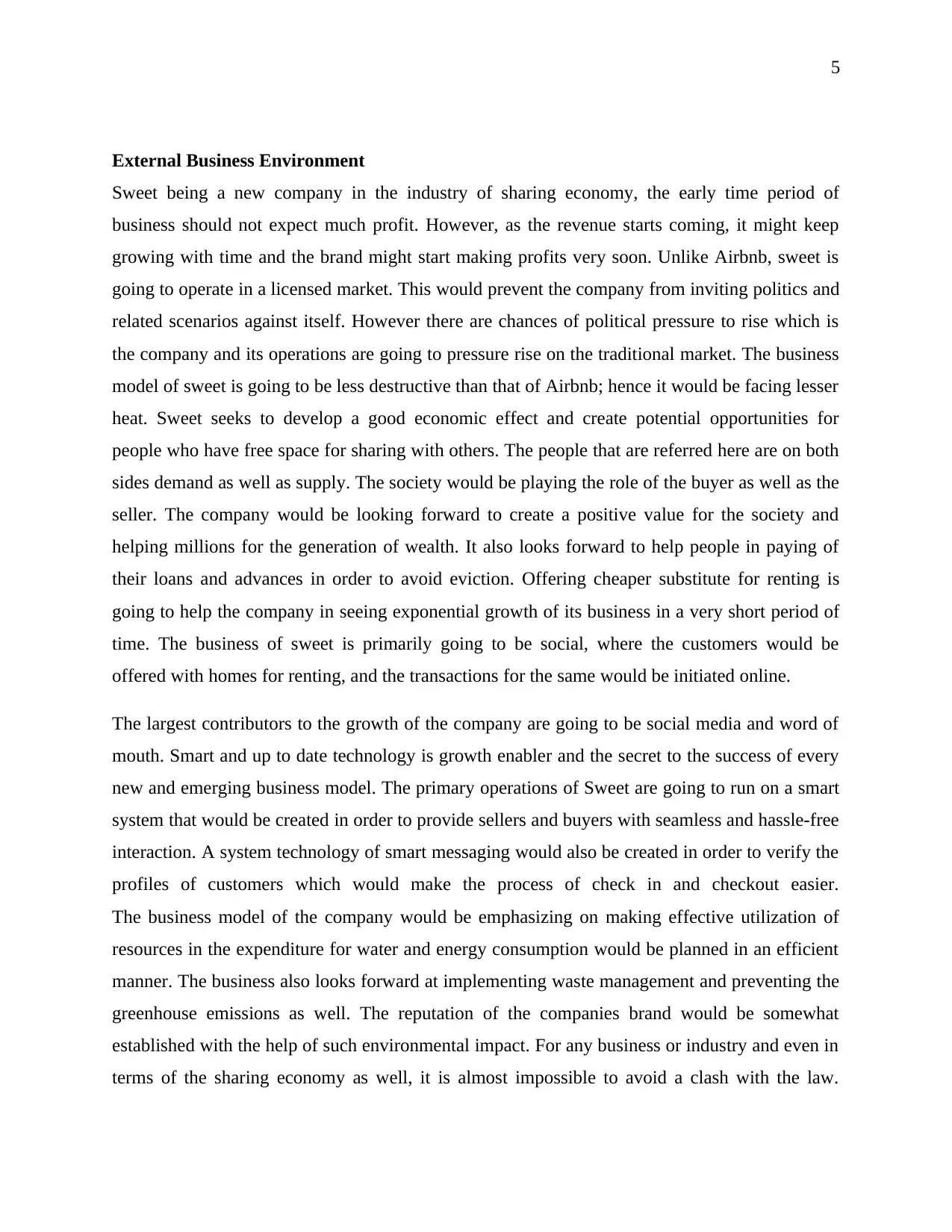
5
External Business Environment
Sweet being a new company in the industry of sharing economy, the early time period of
business should not expect much profit. However, as the revenue starts coming, it might keep
growing with time and the brand might start making profits very soon. Unlike Airbnb, sweet is
going to operate in a licensed market. This would prevent the company from inviting politics and
related scenarios against itself. However there are chances of political pressure to rise which is
the company and its operations are going to pressure rise on the traditional market. The business
model of sweet is going to be less destructive than that of Airbnb; hence it would be facing lesser
heat. Sweet seeks to develop a good economic effect and create potential opportunities for
people who have free space for sharing with others. The people that are referred here are on both
sides demand as well as supply. The society would be playing the role of the buyer as well as the
seller. The company would be looking forward to create a positive value for the society and
helping millions for the generation of wealth. It also looks forward to help people in paying of
their loans and advances in order to avoid eviction. Offering cheaper substitute for renting is
going to help the company in seeing exponential growth of its business in a very short period of
time. The business of sweet is primarily going to be social, where the customers would be
offered with homes for renting, and the transactions for the same would be initiated online.
The largest contributors to the growth of the company are going to be social media and word of
mouth. Smart and up to date technology is growth enabler and the secret to the success of every
new and emerging business model. The primary operations of Sweet are going to run on a smart
system that would be created in order to provide sellers and buyers with seamless and hassle-free
interaction. A system technology of smart messaging would also be created in order to verify the
profiles of customers which would make the process of check in and checkout easier.
The business model of the company would be emphasizing on making effective utilization of
resources in the expenditure for water and energy consumption would be planned in an efficient
manner. The business also looks forward at implementing waste management and preventing the
greenhouse emissions as well. The reputation of the companies brand would be somewhat
established with the help of such environmental impact. For any business or industry and even in
terms of the sharing economy as well, it is almost impossible to avoid a clash with the law.
External Business Environment
Sweet being a new company in the industry of sharing economy, the early time period of
business should not expect much profit. However, as the revenue starts coming, it might keep
growing with time and the brand might start making profits very soon. Unlike Airbnb, sweet is
going to operate in a licensed market. This would prevent the company from inviting politics and
related scenarios against itself. However there are chances of political pressure to rise which is
the company and its operations are going to pressure rise on the traditional market. The business
model of sweet is going to be less destructive than that of Airbnb; hence it would be facing lesser
heat. Sweet seeks to develop a good economic effect and create potential opportunities for
people who have free space for sharing with others. The people that are referred here are on both
sides demand as well as supply. The society would be playing the role of the buyer as well as the
seller. The company would be looking forward to create a positive value for the society and
helping millions for the generation of wealth. It also looks forward to help people in paying of
their loans and advances in order to avoid eviction. Offering cheaper substitute for renting is
going to help the company in seeing exponential growth of its business in a very short period of
time. The business of sweet is primarily going to be social, where the customers would be
offered with homes for renting, and the transactions for the same would be initiated online.
The largest contributors to the growth of the company are going to be social media and word of
mouth. Smart and up to date technology is growth enabler and the secret to the success of every
new and emerging business model. The primary operations of Sweet are going to run on a smart
system that would be created in order to provide sellers and buyers with seamless and hassle-free
interaction. A system technology of smart messaging would also be created in order to verify the
profiles of customers which would make the process of check in and checkout easier.
The business model of the company would be emphasizing on making effective utilization of
resources in the expenditure for water and energy consumption would be planned in an efficient
manner. The business also looks forward at implementing waste management and preventing the
greenhouse emissions as well. The reputation of the companies brand would be somewhat
established with the help of such environmental impact. For any business or industry and even in
terms of the sharing economy as well, it is almost impossible to avoid a clash with the law.
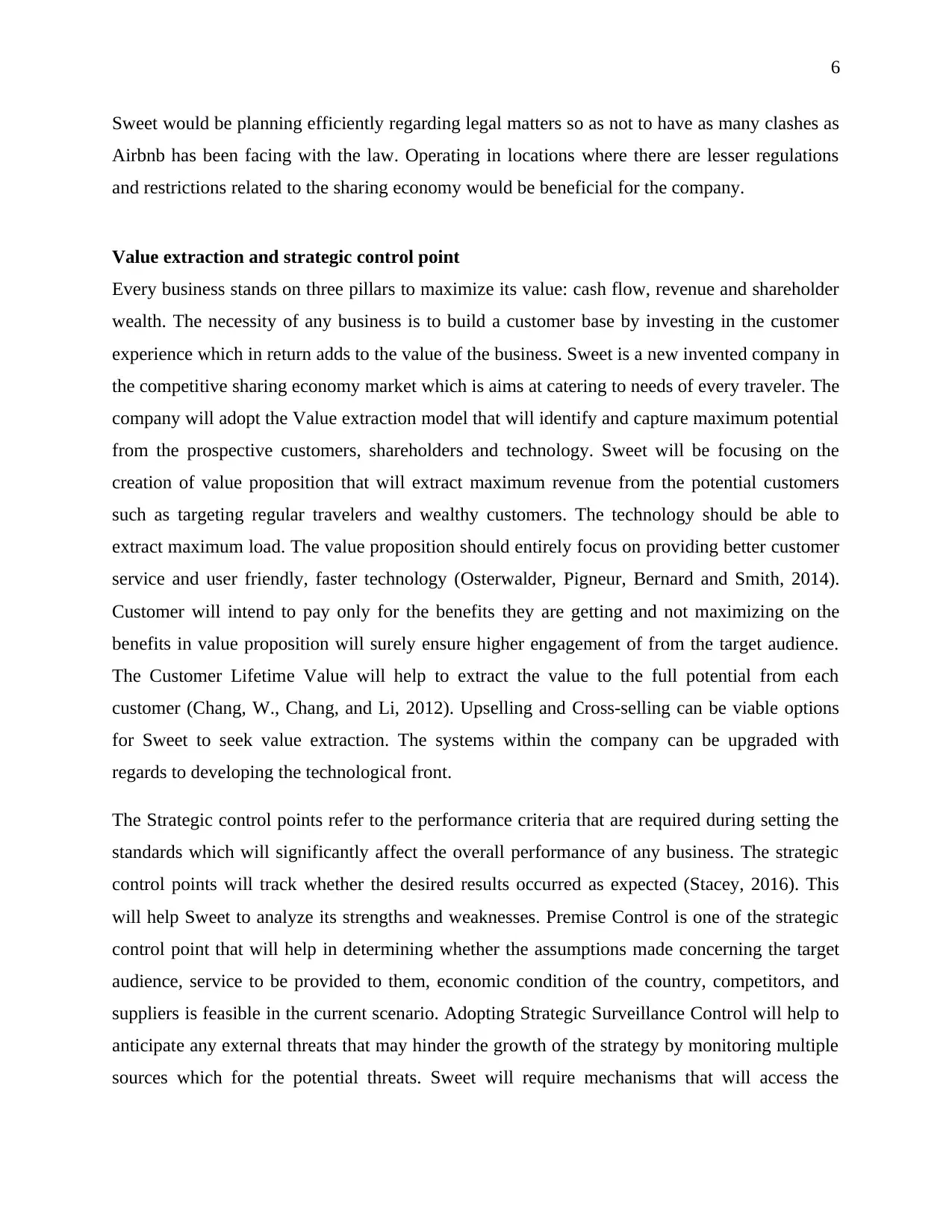
6
Sweet would be planning efficiently regarding legal matters so as not to have as many clashes as
Airbnb has been facing with the law. Operating in locations where there are lesser regulations
and restrictions related to the sharing economy would be beneficial for the company.
Value extraction and strategic control point
Every business stands on three pillars to maximize its value: cash flow, revenue and shareholder
wealth. The necessity of any business is to build a customer base by investing in the customer
experience which in return adds to the value of the business. Sweet is a new invented company in
the competitive sharing economy market which is aims at catering to needs of every traveler. The
company will adopt the Value extraction model that will identify and capture maximum potential
from the prospective customers, shareholders and technology. Sweet will be focusing on the
creation of value proposition that will extract maximum revenue from the potential customers
such as targeting regular travelers and wealthy customers. The technology should be able to
extract maximum load. The value proposition should entirely focus on providing better customer
service and user friendly, faster technology (Osterwalder, Pigneur, Bernard and Smith, 2014).
Customer will intend to pay only for the benefits they are getting and not maximizing on the
benefits in value proposition will surely ensure higher engagement of from the target audience.
The Customer Lifetime Value will help to extract the value to the full potential from each
customer (Chang, W., Chang, and Li, 2012). Upselling and Cross-selling can be viable options
for Sweet to seek value extraction. The systems within the company can be upgraded with
regards to developing the technological front.
The Strategic control points refer to the performance criteria that are required during setting the
standards which will significantly affect the overall performance of any business. The strategic
control points will track whether the desired results occurred as expected (Stacey, 2016). This
will help Sweet to analyze its strengths and weaknesses. Premise Control is one of the strategic
control point that will help in determining whether the assumptions made concerning the target
audience, service to be provided to them, economic condition of the country, competitors, and
suppliers is feasible in the current scenario. Adopting Strategic Surveillance Control will help to
anticipate any external threats that may hinder the growth of the strategy by monitoring multiple
sources which for the potential threats. Sweet will require mechanisms that will access the
Sweet would be planning efficiently regarding legal matters so as not to have as many clashes as
Airbnb has been facing with the law. Operating in locations where there are lesser regulations
and restrictions related to the sharing economy would be beneficial for the company.
Value extraction and strategic control point
Every business stands on three pillars to maximize its value: cash flow, revenue and shareholder
wealth. The necessity of any business is to build a customer base by investing in the customer
experience which in return adds to the value of the business. Sweet is a new invented company in
the competitive sharing economy market which is aims at catering to needs of every traveler. The
company will adopt the Value extraction model that will identify and capture maximum potential
from the prospective customers, shareholders and technology. Sweet will be focusing on the
creation of value proposition that will extract maximum revenue from the potential customers
such as targeting regular travelers and wealthy customers. The technology should be able to
extract maximum load. The value proposition should entirely focus on providing better customer
service and user friendly, faster technology (Osterwalder, Pigneur, Bernard and Smith, 2014).
Customer will intend to pay only for the benefits they are getting and not maximizing on the
benefits in value proposition will surely ensure higher engagement of from the target audience.
The Customer Lifetime Value will help to extract the value to the full potential from each
customer (Chang, W., Chang, and Li, 2012). Upselling and Cross-selling can be viable options
for Sweet to seek value extraction. The systems within the company can be upgraded with
regards to developing the technological front.
The Strategic control points refer to the performance criteria that are required during setting the
standards which will significantly affect the overall performance of any business. The strategic
control points will track whether the desired results occurred as expected (Stacey, 2016). This
will help Sweet to analyze its strengths and weaknesses. Premise Control is one of the strategic
control point that will help in determining whether the assumptions made concerning the target
audience, service to be provided to them, economic condition of the country, competitors, and
suppliers is feasible in the current scenario. Adopting Strategic Surveillance Control will help to
anticipate any external threats that may hinder the growth of the strategy by monitoring multiple
sources which for the potential threats. Sweet will require mechanisms that will access the
⊘ This is a preview!⊘
Do you want full access?
Subscribe today to unlock all pages.

Trusted by 1+ million students worldwide
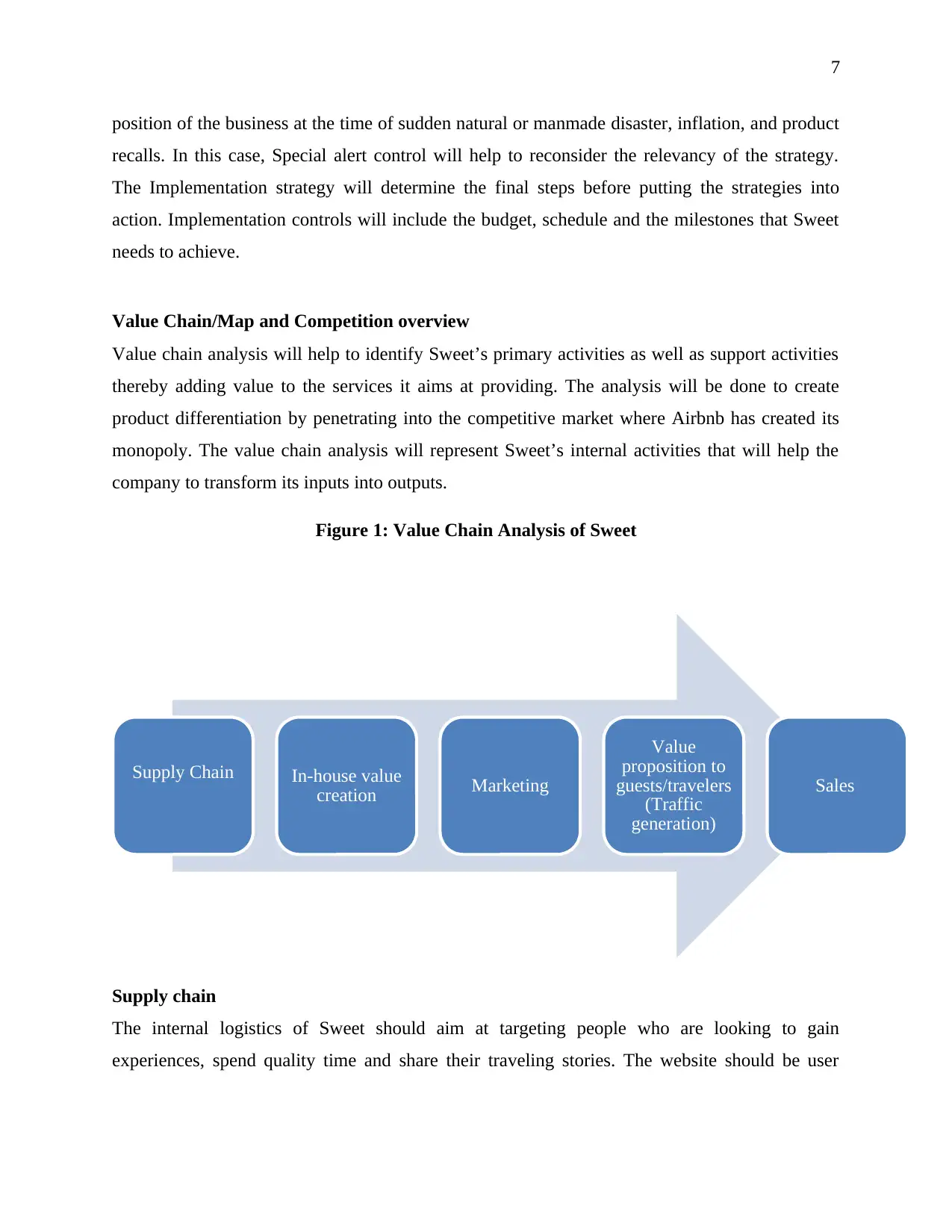
7
position of the business at the time of sudden natural or manmade disaster, inflation, and product
recalls. In this case, Special alert control will help to reconsider the relevancy of the strategy.
The Implementation strategy will determine the final steps before putting the strategies into
action. Implementation controls will include the budget, schedule and the milestones that Sweet
needs to achieve.
Value Chain/Map and Competition overview
Value chain analysis will help to identify Sweet’s primary activities as well as support activities
thereby adding value to the services it aims at providing. The analysis will be done to create
product differentiation by penetrating into the competitive market where Airbnb has created its
monopoly. The value chain analysis will represent Sweet’s internal activities that will help the
company to transform its inputs into outputs.
Figure 1: Value Chain Analysis of Sweet
Supply chain
The internal logistics of Sweet should aim at targeting people who are looking to gain
experiences, spend quality time and share their traveling stories. The website should be user
Supply Chain In-house value
creation Marketing
Value
proposition to
guests/travelers
(Traffic
generation)
Sales
position of the business at the time of sudden natural or manmade disaster, inflation, and product
recalls. In this case, Special alert control will help to reconsider the relevancy of the strategy.
The Implementation strategy will determine the final steps before putting the strategies into
action. Implementation controls will include the budget, schedule and the milestones that Sweet
needs to achieve.
Value Chain/Map and Competition overview
Value chain analysis will help to identify Sweet’s primary activities as well as support activities
thereby adding value to the services it aims at providing. The analysis will be done to create
product differentiation by penetrating into the competitive market where Airbnb has created its
monopoly. The value chain analysis will represent Sweet’s internal activities that will help the
company to transform its inputs into outputs.
Figure 1: Value Chain Analysis of Sweet
Supply chain
The internal logistics of Sweet should aim at targeting people who are looking to gain
experiences, spend quality time and share their traveling stories. The website should be user
Supply Chain In-house value
creation Marketing
Value
proposition to
guests/travelers
(Traffic
generation)
Sales
Paraphrase This Document
Need a fresh take? Get an instant paraphrase of this document with our AI Paraphraser
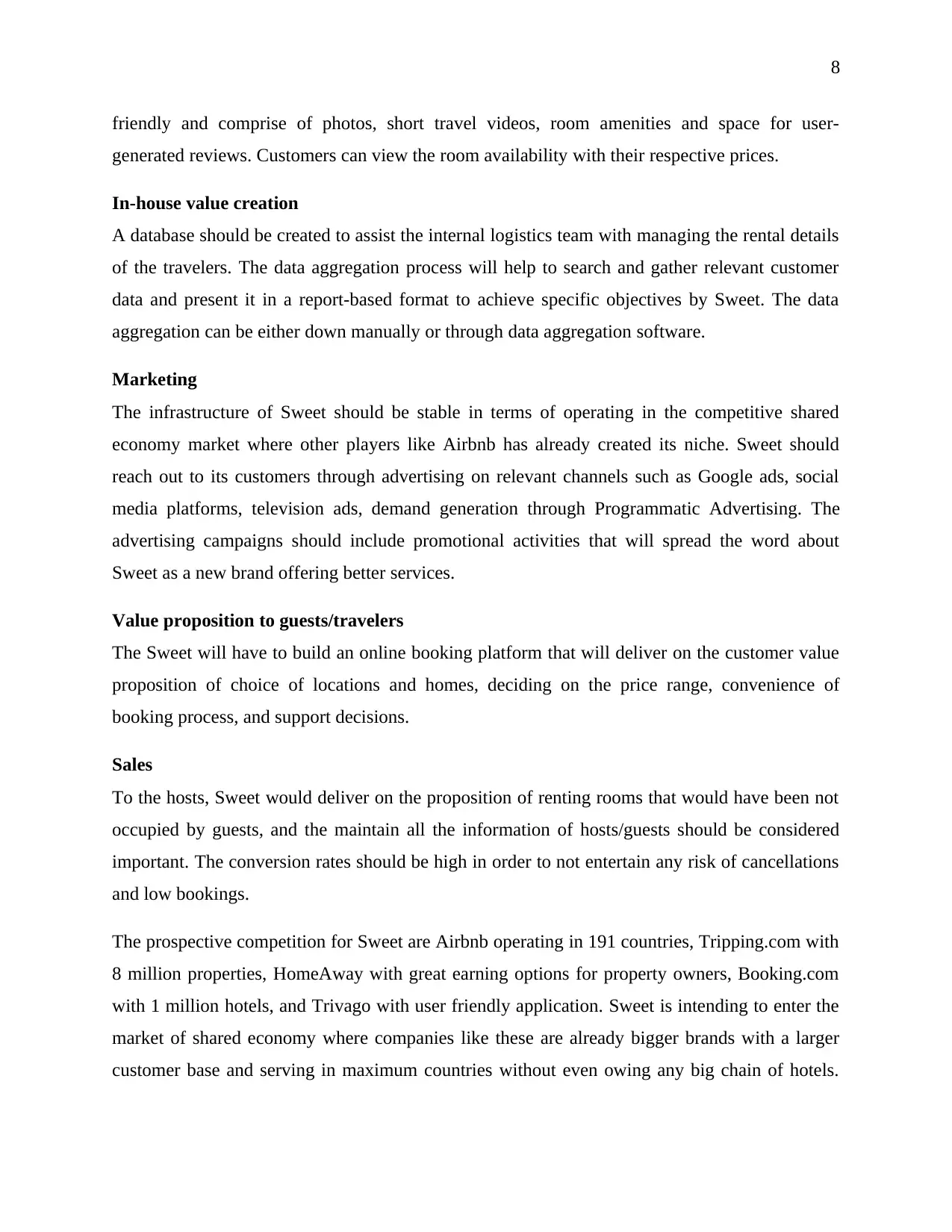
8
friendly and comprise of photos, short travel videos, room amenities and space for user-
generated reviews. Customers can view the room availability with their respective prices.
In-house value creation
A database should be created to assist the internal logistics team with managing the rental details
of the travelers. The data aggregation process will help to search and gather relevant customer
data and present it in a report-based format to achieve specific objectives by Sweet. The data
aggregation can be either down manually or through data aggregation software.
Marketing
The infrastructure of Sweet should be stable in terms of operating in the competitive shared
economy market where other players like Airbnb has already created its niche. Sweet should
reach out to its customers through advertising on relevant channels such as Google ads, social
media platforms, television ads, demand generation through Programmatic Advertising. The
advertising campaigns should include promotional activities that will spread the word about
Sweet as a new brand offering better services.
Value proposition to guests/travelers
The Sweet will have to build an online booking platform that will deliver on the customer value
proposition of choice of locations and homes, deciding on the price range, convenience of
booking process, and support decisions.
Sales
To the hosts, Sweet would deliver on the proposition of renting rooms that would have been not
occupied by guests, and the maintain all the information of hosts/guests should be considered
important. The conversion rates should be high in order to not entertain any risk of cancellations
and low bookings.
The prospective competition for Sweet are Airbnb operating in 191 countries, Tripping.com with
8 million properties, HomeAway with great earning options for property owners, Booking.com
with 1 million hotels, and Trivago with user friendly application. Sweet is intending to enter the
market of shared economy where companies like these are already bigger brands with a larger
customer base and serving in maximum countries without even owing any big chain of hotels.
friendly and comprise of photos, short travel videos, room amenities and space for user-
generated reviews. Customers can view the room availability with their respective prices.
In-house value creation
A database should be created to assist the internal logistics team with managing the rental details
of the travelers. The data aggregation process will help to search and gather relevant customer
data and present it in a report-based format to achieve specific objectives by Sweet. The data
aggregation can be either down manually or through data aggregation software.
Marketing
The infrastructure of Sweet should be stable in terms of operating in the competitive shared
economy market where other players like Airbnb has already created its niche. Sweet should
reach out to its customers through advertising on relevant channels such as Google ads, social
media platforms, television ads, demand generation through Programmatic Advertising. The
advertising campaigns should include promotional activities that will spread the word about
Sweet as a new brand offering better services.
Value proposition to guests/travelers
The Sweet will have to build an online booking platform that will deliver on the customer value
proposition of choice of locations and homes, deciding on the price range, convenience of
booking process, and support decisions.
Sales
To the hosts, Sweet would deliver on the proposition of renting rooms that would have been not
occupied by guests, and the maintain all the information of hosts/guests should be considered
important. The conversion rates should be high in order to not entertain any risk of cancellations
and low bookings.
The prospective competition for Sweet are Airbnb operating in 191 countries, Tripping.com with
8 million properties, HomeAway with great earning options for property owners, Booking.com
with 1 million hotels, and Trivago with user friendly application. Sweet is intending to enter the
market of shared economy where companies like these are already bigger brands with a larger
customer base and serving in maximum countries without even owing any big chain of hotels.
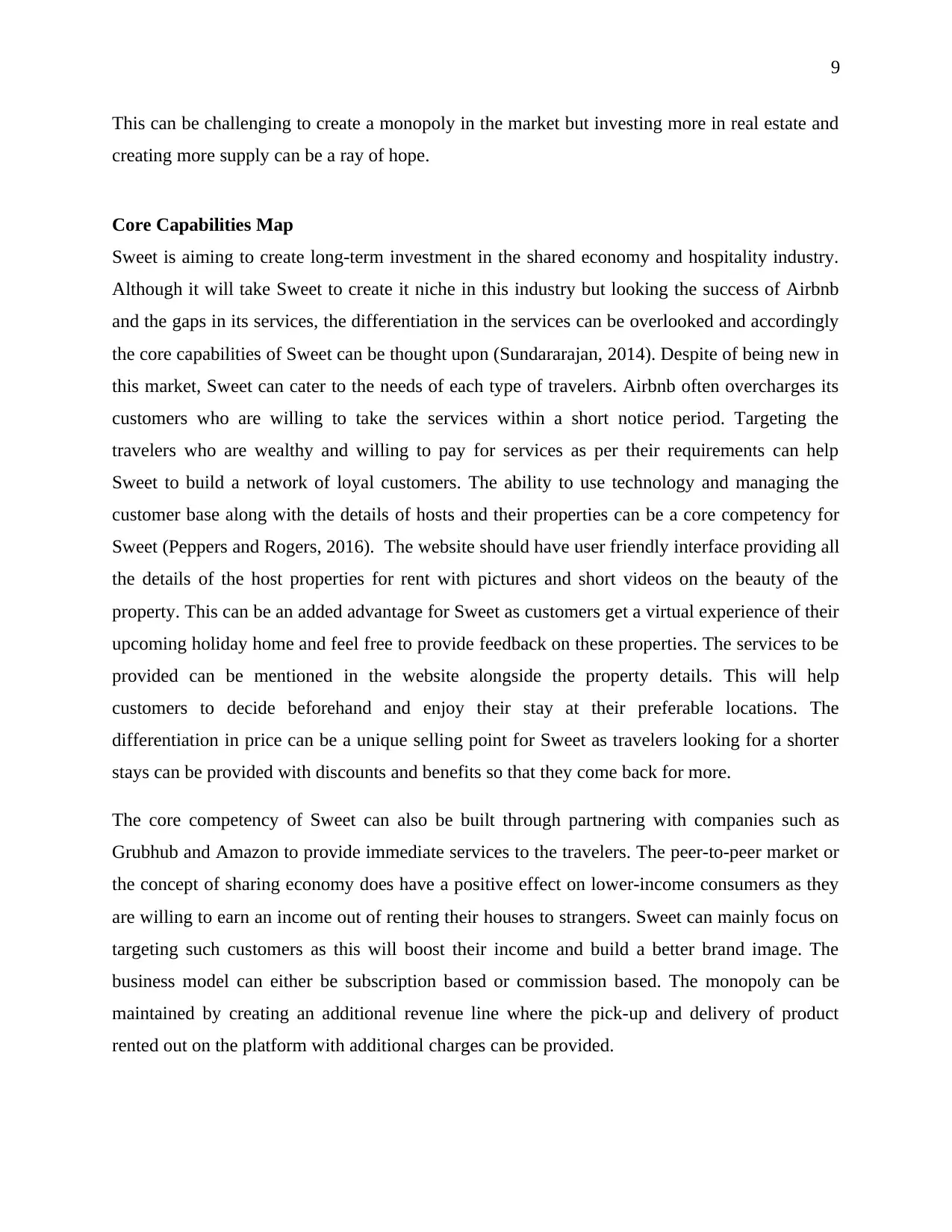
9
This can be challenging to create a monopoly in the market but investing more in real estate and
creating more supply can be a ray of hope.
Core Capabilities Map
Sweet is aiming to create long-term investment in the shared economy and hospitality industry.
Although it will take Sweet to create it niche in this industry but looking the success of Airbnb
and the gaps in its services, the differentiation in the services can be overlooked and accordingly
the core capabilities of Sweet can be thought upon (Sundararajan, 2014). Despite of being new in
this market, Sweet can cater to the needs of each type of travelers. Airbnb often overcharges its
customers who are willing to take the services within a short notice period. Targeting the
travelers who are wealthy and willing to pay for services as per their requirements can help
Sweet to build a network of loyal customers. The ability to use technology and managing the
customer base along with the details of hosts and their properties can be a core competency for
Sweet (Peppers and Rogers, 2016). The website should have user friendly interface providing all
the details of the host properties for rent with pictures and short videos on the beauty of the
property. This can be an added advantage for Sweet as customers get a virtual experience of their
upcoming holiday home and feel free to provide feedback on these properties. The services to be
provided can be mentioned in the website alongside the property details. This will help
customers to decide beforehand and enjoy their stay at their preferable locations. The
differentiation in price can be a unique selling point for Sweet as travelers looking for a shorter
stays can be provided with discounts and benefits so that they come back for more.
The core competency of Sweet can also be built through partnering with companies such as
Grubhub and Amazon to provide immediate services to the travelers. The peer-to-peer market or
the concept of sharing economy does have a positive effect on lower-income consumers as they
are willing to earn an income out of renting their houses to strangers. Sweet can mainly focus on
targeting such customers as this will boost their income and build a better brand image. The
business model can either be subscription based or commission based. The monopoly can be
maintained by creating an additional revenue line where the pick-up and delivery of product
rented out on the platform with additional charges can be provided.
This can be challenging to create a monopoly in the market but investing more in real estate and
creating more supply can be a ray of hope.
Core Capabilities Map
Sweet is aiming to create long-term investment in the shared economy and hospitality industry.
Although it will take Sweet to create it niche in this industry but looking the success of Airbnb
and the gaps in its services, the differentiation in the services can be overlooked and accordingly
the core capabilities of Sweet can be thought upon (Sundararajan, 2014). Despite of being new in
this market, Sweet can cater to the needs of each type of travelers. Airbnb often overcharges its
customers who are willing to take the services within a short notice period. Targeting the
travelers who are wealthy and willing to pay for services as per their requirements can help
Sweet to build a network of loyal customers. The ability to use technology and managing the
customer base along with the details of hosts and their properties can be a core competency for
Sweet (Peppers and Rogers, 2016). The website should have user friendly interface providing all
the details of the host properties for rent with pictures and short videos on the beauty of the
property. This can be an added advantage for Sweet as customers get a virtual experience of their
upcoming holiday home and feel free to provide feedback on these properties. The services to be
provided can be mentioned in the website alongside the property details. This will help
customers to decide beforehand and enjoy their stay at their preferable locations. The
differentiation in price can be a unique selling point for Sweet as travelers looking for a shorter
stays can be provided with discounts and benefits so that they come back for more.
The core competency of Sweet can also be built through partnering with companies such as
Grubhub and Amazon to provide immediate services to the travelers. The peer-to-peer market or
the concept of sharing economy does have a positive effect on lower-income consumers as they
are willing to earn an income out of renting their houses to strangers. Sweet can mainly focus on
targeting such customers as this will boost their income and build a better brand image. The
business model can either be subscription based or commission based. The monopoly can be
maintained by creating an additional revenue line where the pick-up and delivery of product
rented out on the platform with additional charges can be provided.
⊘ This is a preview!⊘
Do you want full access?
Subscribe today to unlock all pages.

Trusted by 1+ million students worldwide
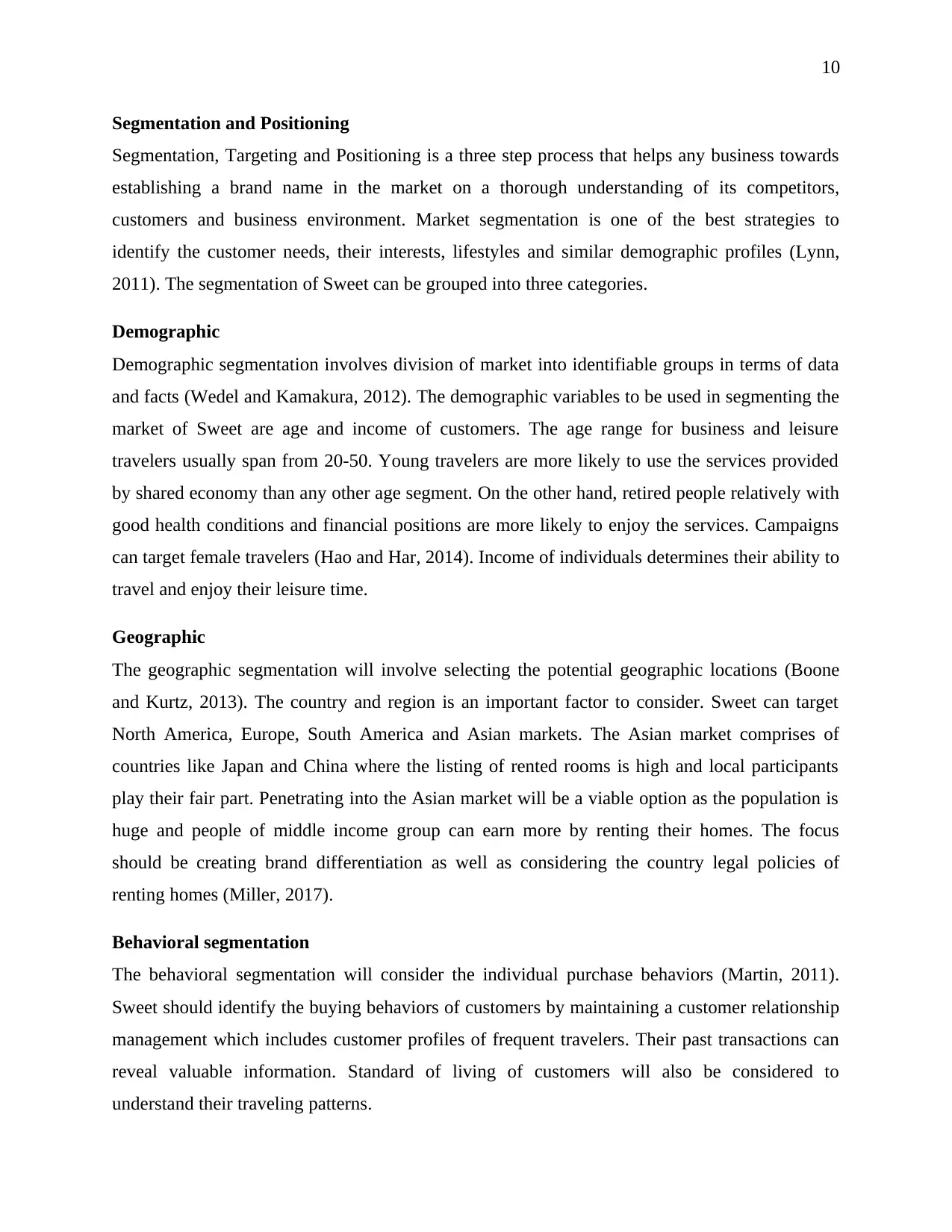
10
Segmentation and Positioning
Segmentation, Targeting and Positioning is a three step process that helps any business towards
establishing a brand name in the market on a thorough understanding of its competitors,
customers and business environment. Market segmentation is one of the best strategies to
identify the customer needs, their interests, lifestyles and similar demographic profiles (Lynn,
2011). The segmentation of Sweet can be grouped into three categories.
Demographic
Demographic segmentation involves division of market into identifiable groups in terms of data
and facts (Wedel and Kamakura, 2012). The demographic variables to be used in segmenting the
market of Sweet are age and income of customers. The age range for business and leisure
travelers usually span from 20-50. Young travelers are more likely to use the services provided
by shared economy than any other age segment. On the other hand, retired people relatively with
good health conditions and financial positions are more likely to enjoy the services. Campaigns
can target female travelers (Hao and Har, 2014). Income of individuals determines their ability to
travel and enjoy their leisure time.
Geographic
The geographic segmentation will involve selecting the potential geographic locations (Boone
and Kurtz, 2013). The country and region is an important factor to consider. Sweet can target
North America, Europe, South America and Asian markets. The Asian market comprises of
countries like Japan and China where the listing of rented rooms is high and local participants
play their fair part. Penetrating into the Asian market will be a viable option as the population is
huge and people of middle income group can earn more by renting their homes. The focus
should be creating brand differentiation as well as considering the country legal policies of
renting homes (Miller, 2017).
Behavioral segmentation
The behavioral segmentation will consider the individual purchase behaviors (Martin, 2011).
Sweet should identify the buying behaviors of customers by maintaining a customer relationship
management which includes customer profiles of frequent travelers. Their past transactions can
reveal valuable information. Standard of living of customers will also be considered to
understand their traveling patterns.
Segmentation and Positioning
Segmentation, Targeting and Positioning is a three step process that helps any business towards
establishing a brand name in the market on a thorough understanding of its competitors,
customers and business environment. Market segmentation is one of the best strategies to
identify the customer needs, their interests, lifestyles and similar demographic profiles (Lynn,
2011). The segmentation of Sweet can be grouped into three categories.
Demographic
Demographic segmentation involves division of market into identifiable groups in terms of data
and facts (Wedel and Kamakura, 2012). The demographic variables to be used in segmenting the
market of Sweet are age and income of customers. The age range for business and leisure
travelers usually span from 20-50. Young travelers are more likely to use the services provided
by shared economy than any other age segment. On the other hand, retired people relatively with
good health conditions and financial positions are more likely to enjoy the services. Campaigns
can target female travelers (Hao and Har, 2014). Income of individuals determines their ability to
travel and enjoy their leisure time.
Geographic
The geographic segmentation will involve selecting the potential geographic locations (Boone
and Kurtz, 2013). The country and region is an important factor to consider. Sweet can target
North America, Europe, South America and Asian markets. The Asian market comprises of
countries like Japan and China where the listing of rented rooms is high and local participants
play their fair part. Penetrating into the Asian market will be a viable option as the population is
huge and people of middle income group can earn more by renting their homes. The focus
should be creating brand differentiation as well as considering the country legal policies of
renting homes (Miller, 2017).
Behavioral segmentation
The behavioral segmentation will consider the individual purchase behaviors (Martin, 2011).
Sweet should identify the buying behaviors of customers by maintaining a customer relationship
management which includes customer profiles of frequent travelers. Their past transactions can
reveal valuable information. Standard of living of customers will also be considered to
understand their traveling patterns.
Paraphrase This Document
Need a fresh take? Get an instant paraphrase of this document with our AI Paraphraser
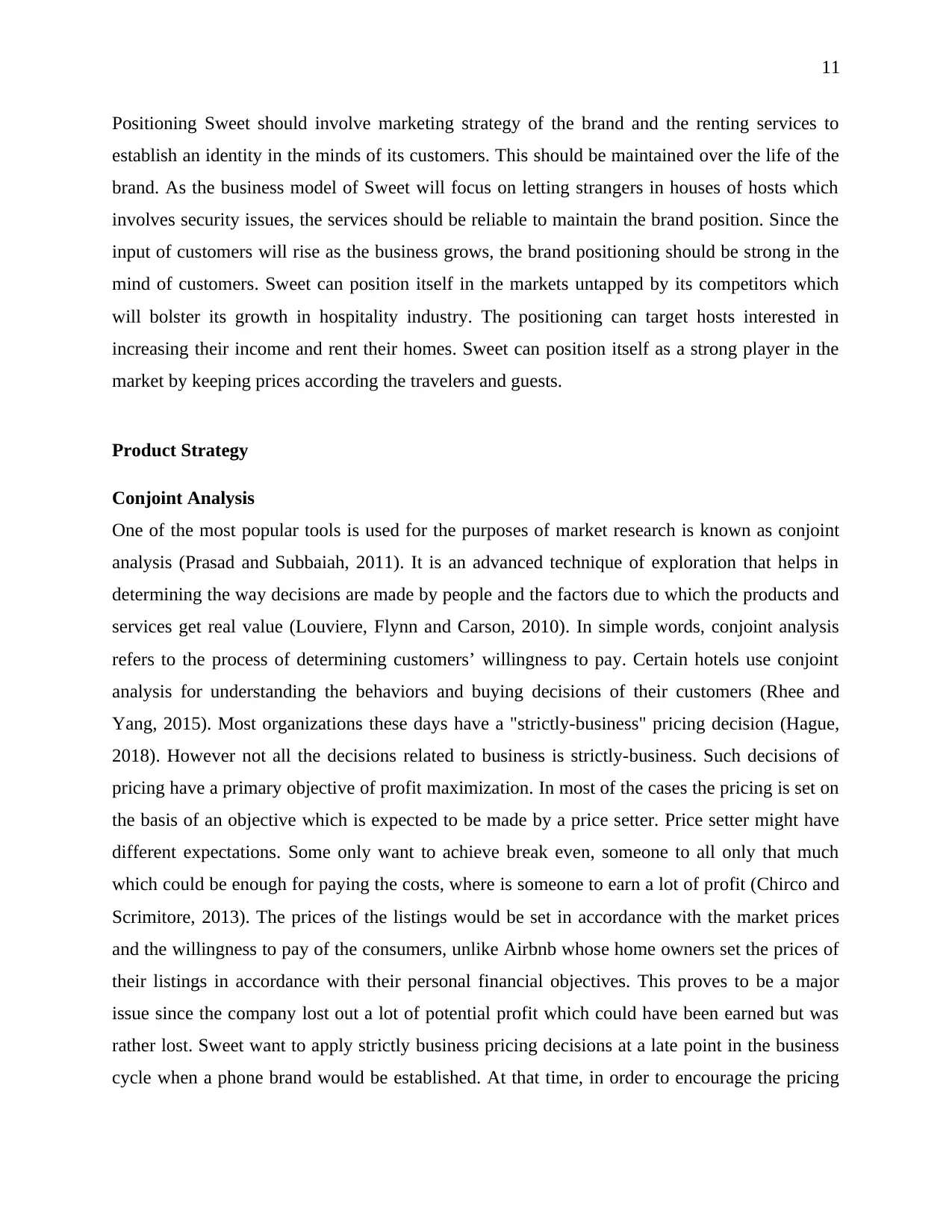
11
Positioning Sweet should involve marketing strategy of the brand and the renting services to
establish an identity in the minds of its customers. This should be maintained over the life of the
brand. As the business model of Sweet will focus on letting strangers in houses of hosts which
involves security issues, the services should be reliable to maintain the brand position. Since the
input of customers will rise as the business grows, the brand positioning should be strong in the
mind of customers. Sweet can position itself in the markets untapped by its competitors which
will bolster its growth in hospitality industry. The positioning can target hosts interested in
increasing their income and rent their homes. Sweet can position itself as a strong player in the
market by keeping prices according the travelers and guests.
Product Strategy
Conjoint Analysis
One of the most popular tools is used for the purposes of market research is known as conjoint
analysis (Prasad and Subbaiah, 2011). It is an advanced technique of exploration that helps in
determining the way decisions are made by people and the factors due to which the products and
services get real value (Louviere, Flynn and Carson, 2010). In simple words, conjoint analysis
refers to the process of determining customers’ willingness to pay. Certain hotels use conjoint
analysis for understanding the behaviors and buying decisions of their customers (Rhee and
Yang, 2015). Most organizations these days have a "strictly-business" pricing decision (Hague,
2018). However not all the decisions related to business is strictly-business. Such decisions of
pricing have a primary objective of profit maximization. In most of the cases the pricing is set on
the basis of an objective which is expected to be made by a price setter. Price setter might have
different expectations. Some only want to achieve break even, someone to all only that much
which could be enough for paying the costs, where is someone to earn a lot of profit (Chirco and
Scrimitore, 2013). The prices of the listings would be set in accordance with the market prices
and the willingness to pay of the consumers, unlike Airbnb whose home owners set the prices of
their listings in accordance with their personal financial objectives. This proves to be a major
issue since the company lost out a lot of potential profit which could have been earned but was
rather lost. Sweet want to apply strictly business pricing decisions at a late point in the business
cycle when a phone brand would be established. At that time, in order to encourage the pricing
Positioning Sweet should involve marketing strategy of the brand and the renting services to
establish an identity in the minds of its customers. This should be maintained over the life of the
brand. As the business model of Sweet will focus on letting strangers in houses of hosts which
involves security issues, the services should be reliable to maintain the brand position. Since the
input of customers will rise as the business grows, the brand positioning should be strong in the
mind of customers. Sweet can position itself in the markets untapped by its competitors which
will bolster its growth in hospitality industry. The positioning can target hosts interested in
increasing their income and rent their homes. Sweet can position itself as a strong player in the
market by keeping prices according the travelers and guests.
Product Strategy
Conjoint Analysis
One of the most popular tools is used for the purposes of market research is known as conjoint
analysis (Prasad and Subbaiah, 2011). It is an advanced technique of exploration that helps in
determining the way decisions are made by people and the factors due to which the products and
services get real value (Louviere, Flynn and Carson, 2010). In simple words, conjoint analysis
refers to the process of determining customers’ willingness to pay. Certain hotels use conjoint
analysis for understanding the behaviors and buying decisions of their customers (Rhee and
Yang, 2015). Most organizations these days have a "strictly-business" pricing decision (Hague,
2018). However not all the decisions related to business is strictly-business. Such decisions of
pricing have a primary objective of profit maximization. In most of the cases the pricing is set on
the basis of an objective which is expected to be made by a price setter. Price setter might have
different expectations. Some only want to achieve break even, someone to all only that much
which could be enough for paying the costs, where is someone to earn a lot of profit (Chirco and
Scrimitore, 2013). The prices of the listings would be set in accordance with the market prices
and the willingness to pay of the consumers, unlike Airbnb whose home owners set the prices of
their listings in accordance with their personal financial objectives. This proves to be a major
issue since the company lost out a lot of potential profit which could have been earned but was
rather lost. Sweet want to apply strictly business pricing decisions at a late point in the business
cycle when a phone brand would be established. At that time, in order to encourage the pricing
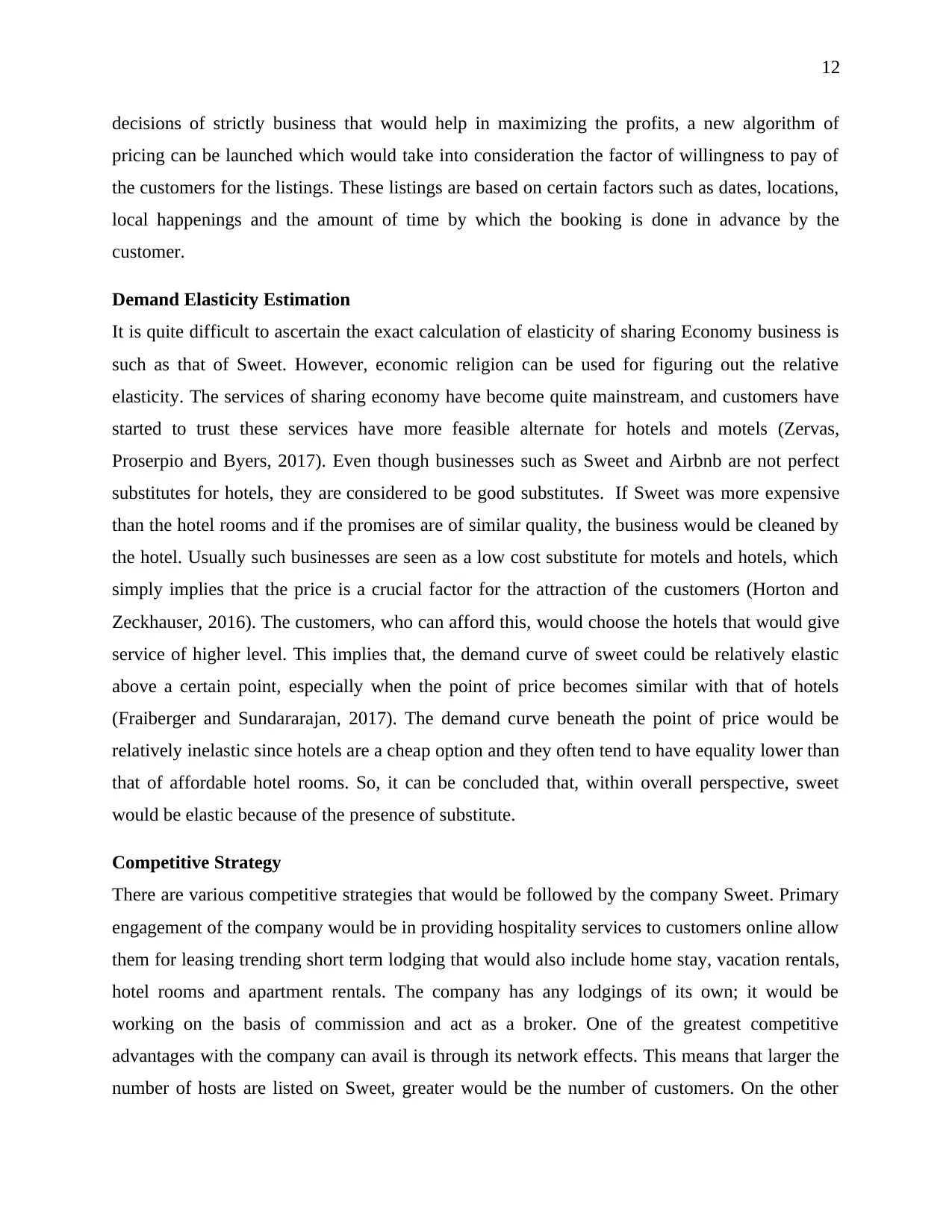
12
decisions of strictly business that would help in maximizing the profits, a new algorithm of
pricing can be launched which would take into consideration the factor of willingness to pay of
the customers for the listings. These listings are based on certain factors such as dates, locations,
local happenings and the amount of time by which the booking is done in advance by the
customer.
Demand Elasticity Estimation
It is quite difficult to ascertain the exact calculation of elasticity of sharing Economy business is
such as that of Sweet. However, economic religion can be used for figuring out the relative
elasticity. The services of sharing economy have become quite mainstream, and customers have
started to trust these services have more feasible alternate for hotels and motels (Zervas,
Proserpio and Byers, 2017). Even though businesses such as Sweet and Airbnb are not perfect
substitutes for hotels, they are considered to be good substitutes. If Sweet was more expensive
than the hotel rooms and if the promises are of similar quality, the business would be cleaned by
the hotel. Usually such businesses are seen as a low cost substitute for motels and hotels, which
simply implies that the price is a crucial factor for the attraction of the customers (Horton and
Zeckhauser, 2016). The customers, who can afford this, would choose the hotels that would give
service of higher level. This implies that, the demand curve of sweet could be relatively elastic
above a certain point, especially when the point of price becomes similar with that of hotels
(Fraiberger and Sundararajan, 2017). The demand curve beneath the point of price would be
relatively inelastic since hotels are a cheap option and they often tend to have equality lower than
that of affordable hotel rooms. So, it can be concluded that, within overall perspective, sweet
would be elastic because of the presence of substitute.
Competitive Strategy
There are various competitive strategies that would be followed by the company Sweet. Primary
engagement of the company would be in providing hospitality services to customers online allow
them for leasing trending short term lodging that would also include home stay, vacation rentals,
hotel rooms and apartment rentals. The company has any lodgings of its own; it would be
working on the basis of commission and act as a broker. One of the greatest competitive
advantages with the company can avail is through its network effects. This means that larger the
number of hosts are listed on Sweet, greater would be the number of customers. On the other
decisions of strictly business that would help in maximizing the profits, a new algorithm of
pricing can be launched which would take into consideration the factor of willingness to pay of
the customers for the listings. These listings are based on certain factors such as dates, locations,
local happenings and the amount of time by which the booking is done in advance by the
customer.
Demand Elasticity Estimation
It is quite difficult to ascertain the exact calculation of elasticity of sharing Economy business is
such as that of Sweet. However, economic religion can be used for figuring out the relative
elasticity. The services of sharing economy have become quite mainstream, and customers have
started to trust these services have more feasible alternate for hotels and motels (Zervas,
Proserpio and Byers, 2017). Even though businesses such as Sweet and Airbnb are not perfect
substitutes for hotels, they are considered to be good substitutes. If Sweet was more expensive
than the hotel rooms and if the promises are of similar quality, the business would be cleaned by
the hotel. Usually such businesses are seen as a low cost substitute for motels and hotels, which
simply implies that the price is a crucial factor for the attraction of the customers (Horton and
Zeckhauser, 2016). The customers, who can afford this, would choose the hotels that would give
service of higher level. This implies that, the demand curve of sweet could be relatively elastic
above a certain point, especially when the point of price becomes similar with that of hotels
(Fraiberger and Sundararajan, 2017). The demand curve beneath the point of price would be
relatively inelastic since hotels are a cheap option and they often tend to have equality lower than
that of affordable hotel rooms. So, it can be concluded that, within overall perspective, sweet
would be elastic because of the presence of substitute.
Competitive Strategy
There are various competitive strategies that would be followed by the company Sweet. Primary
engagement of the company would be in providing hospitality services to customers online allow
them for leasing trending short term lodging that would also include home stay, vacation rentals,
hotel rooms and apartment rentals. The company has any lodgings of its own; it would be
working on the basis of commission and act as a broker. One of the greatest competitive
advantages with the company can avail is through its network effects. This means that larger the
number of hosts are listed on Sweet, greater would be the number of customers. On the other
⊘ This is a preview!⊘
Do you want full access?
Subscribe today to unlock all pages.

Trusted by 1+ million students worldwide
1 out of 25
Related Documents
Your All-in-One AI-Powered Toolkit for Academic Success.
+13062052269
info@desklib.com
Available 24*7 on WhatsApp / Email
![[object Object]](/_next/static/media/star-bottom.7253800d.svg)
Unlock your academic potential
Copyright © 2020–2025 A2Z Services. All Rights Reserved. Developed and managed by ZUCOL.





